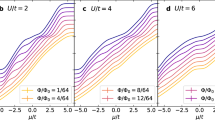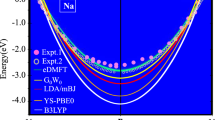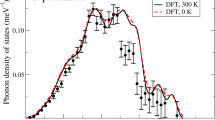Abstract
Given the practical importance of metallic plutonium, there is considerable interest1,2,3 in understanding its fundamental properties. Plutonium undergoes a 25 per cent increase in volume4 when transformed from its α-phase (which is stable below 400 K) to the δ-phase (stable at around 600 K), an effect that is crucial for issues of long-term storage and disposal. It has long been suspected that this unique property is a consequence of the special location of plutonium in the periodic table, on the border between the light and heavy actinides—here, electron wave–particle duality (or itinerant versus localized behaviour) is important5. This situation has resisted previous theoretical treatment. Here we report an electronic structure method, based on dynamical mean-field theory, that enables interpolation between the band-like and atomic-like behaviour of the electron. Our approach enables us to study the phase diagram of plutonium, by providing access to the energetics and one-electron spectra of strongly correlated systems. We explain the origin of the volume expansion between the α- and δ-phases, predict the existence of a strong quasiparticle peak near the Fermi level and give a new viewpoint on the physics of plutonium, in which the α- and δ-phases are on opposite sides of the interaction-driven localization–delocalization transition.
This is a preview of subscription content, access via your institution
Access options
Subscribe to this journal
Receive 51 print issues and online access
$199.00 per year
only $3.90 per issue
Buy this article
- Purchase on Springer Link
- Instant access to full article PDF
Prices may be subject to local taxes which are calculated during checkout


Similar content being viewed by others
References
Broad, W. J. Russian plutonium research raises nuclear questions. New York Times 25 Jan. (2000).
Jeanloz, R. Science-based stockpile stewardship. Phys. Today 12, 44–50 (2000).
Hecker, S. S. & Timofeeva, L. F. A tale of two diagrams. Los Alamos Sci. 26, 244–251 (2000).
Freeman, A. J. & Darby, J. B. (eds) The Actinides: Electronic Structure and Related Properties Vols 1 and 2 (Academic, New York, 1974).
Johansson, B. The α-γ transition in cerium is a Mott transition. Phil. Mag. 30, 469–479 (1974).
Lundqvist, S. & March, S. H. (eds) Theory of the Inhomogeneous Electron Gas (Plenum, New York, 1983).
Soderlind, P., Eriksson, O., Johansson, B. & Wills, J. M. Electronic properties of f-electron metals using the generalized gradient approximation. Phys. Rev. B 50, 7291–7294 (1994).
Jones, M. D., Boettger, J. C., Albers, R. C. & Singh, D. J. Theoretical atomic volumes of the light actinides. Phys. Rev. B 61, 4644–4650 (2000).
Solovyev, I. V., Lichtenstein, A. I., Gubanov, V. A., Antropov, V. P. & Andersen, O. K. Spin-polarized relativistic linear-muffin-tin-orbital method: volume-dependent electronic structure and magnetic moment of plutonium. Phys. Rev. B 43, 14414–14422 (1991).
Hubbard, J. Electron correlations in narrow energy bands. Proc. R. Soc. Lond. A 281, 401–423 (1964).
Georges, A., Kotliar, G., Krauth, W. & Rozenberg, M. J. Dynamical mean-field theory of strongly correlated fermion systems and the limit of infinite dimensions. Rev. Mod. Phys. 68, 13–125 (1996).
Anisimov, V. I., Poteryaev, A. I., Korotin, M. A., Anokhin, A. O. & Kotliar, G. First-principles calculations of the electronic structure and spectra of strongly correlated systems: dynamical mean-field theory. J. Phys. Condens. Matt. 35, 7359–7367 (1997).
Nekrasov, I. A. et al. Calculation of photoemission spectra of the doped Mott insulator La1-xSrxTiO3 using LDA+DMFT(QMC). Eur. Phys. J. B 18, 55–61 (2000).
Anderson, P. W. Localized magnetic states in metals. Phys. Rev. 124, 41–53 (1961).
Andersen, O. K. Linear methods in band theory. Phys. Rev. B 12, 3060–3083 (1975).
Fresard, R. & Kotliar, G. Interplay of Mott transition and ferromagnetism in the orbitally degenerate Hubbard model. Phys. Rev. B 56, 12909–12915 (1997).
Nolting, W. & Borgiel, W. Band magnetism in the Hubbard model. Phys. Rev. B 39, 6962–6978 (1989).
Anisimov, V. I., Aryasetiawan, F. & Lichtenstein, A. I. First-principles calculations of the electronic structure and spectra of strongly correlated systems: the LDA+U method. J. Phys. Condens. Matter 9, 767–808 (1997).
Desclaux, J. P. & Freeman, A J. in Handbook on the Physics and Chemistry of the Actinides (eds Freeman, A. J. & Lander, G. H.) Vol. 1 (Elsevier, Amsterdam, 1984).
Arko, A. J., Joyce, J. J., Morales, L., Wills, J. & Jashley, J. Electronic structure of α- and δ-Pu from photoelectron spectroscopy. Phys. Rev. B 62, 1773–1779 (2000).
Savrasov, S. Y. & Kotliar, G. Ground state theory of δ Pu. Phys. Rev. Lett. 84, 3670–3673 (2000).
Bouchet, J., Siberchicot, B., Jollet, F. & Pasturel, A. Equilibrium properties of δ-Pu: LDA+U calculations (LDA equivalent to local density approximation). J. Phys. Condens. Matter 12, 1723–1733 (2000).
Boring, A. M. & Smith, J. L. Plutonium condensed-matter physics—a survey of theory and experiment. Los Alamos Sci. 26, 91–127 (2000).
Lallement, R. Dilatation et pouvoir thermoelectrique du plutonium α a basse temperature. J. Phys. Chem. Solids 24, 1617–1624 (1963).
Acknowledgements
We thank A. Lichtenstein for discussions. This work was supported by the DOE division of Basic Energy Sciences and by Los Alamos National Laboratory.
Author information
Authors and Affiliations
Corresponding author
Rights and permissions
About this article
Cite this article
Savrasov, S., Kotliar, G. & Abrahams, E. Correlated electrons in δ-plutonium within a dynamical mean-field picture. Nature 410, 793–795 (2001). https://doi.org/10.1038/35071035
Received:
Accepted:
Issue Date:
DOI: https://doi.org/10.1038/35071035
This article is cited by
-
From basic properties to the Mott design of correlated delafossites
npj Computational Materials (2021)
-
Phase stabilization by electronic entropy in plutonium
Nature Communications (2019)
-
Phonon density of states for α-plutonium from density-functional theory
Scientific Reports (2019)
-
A molecular dynamics simulation of energetics and diffusion of point defects in a Au–Ag alloy
Bulletin of Materials Science (2019)
-
Valence fluctuation for f electrons in XGaO3 (X = Pu, Ce): a perspective from dynamic mean field theory
Journal of Radioanalytical and Nuclear Chemistry (2019)
Comments
By submitting a comment you agree to abide by our Terms and Community Guidelines. If you find something abusive or that does not comply with our terms or guidelines please flag it as inappropriate.



